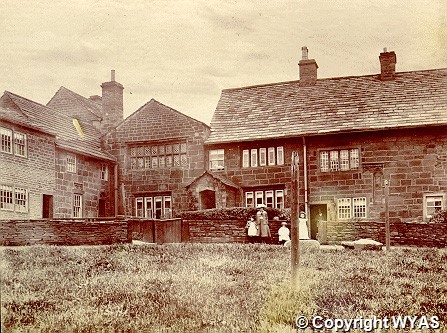Documents and house together then tell a story of a steady climb in wealth and status as the Calverleys (the heirs all called William or Walter) added to their estates bit by bit and married into the leading families in the area. Many were knighted or served as magistrates and later as county sheriff. They never rose higher than that: they were county magnates, not national ones. Some stand out as individuals: Sir Walter, in the 1300s, was a vigorous improver, a pioneer of the iron industry.
A mighty hammer-beamed Great Hall
In the 1480s, a William Calverley married a wealthy Savile heiress and built the current enormous hammer-beamed Great Hall with a great stone fireplace. Its 30-foot span was made possible by the use of projecting hammerbeams, richly carved in the latest fashion. The original entrance was at the west end, where there was a cross passage between two doors, behind a screen and with a fine spere truss above. The first-floor hall now became part of the solar rooms. The chapel was built at the same time, also a very rare survival. It has a private gallery for the family, entered from the solar (now the sitting room), a fine altar window (restored in the 1980s) and a miniature hammerbeam roof, very similar in its detailing to the great hall’s. A panelled oak ceiling is fitted over the two bays at the altar end. The chapel was first restored in the 1980s, reversing changes that had turned it into a cottage.
The Calverley wall paintings
More is known about the 16th Century Calverleys during the difficult years of the Reformation. Chief among them is another William (?1507-72), who was briefly imprisoned in the Tower of London for religious opposition in the 1530s. He learnt his lesson, and embraced Henry VIII’s Protestant regime. He was knighted in 1545 fighting in Scotland, and became Sheriff of Yorkshire in 1548-9. He also found time to produce 17 children with his two wives before his death. Sir William also upgraded his father’s Parlour Block, where in 2022 the painted chamber was discovered beneath plasterboard in a bedroom. Covered in tightly planned wall paintings of Renaissance grotesque-work, it is a room national significance. In the next generation, the Lodging Block was added (dated to the 1580s).
Tragedy and decline
Tragedy struck the family in April 1605, when Sir William’s grandson, Walter Calverley, ran amok, murdering his two small sons, William and Walter. He was executed for his crime by pressing to death. A play was written about this real-life Jacobean tragedy, A Yorkshire Tragedy. This was long attributed to Shakespeare but is now believed to be by Thomas Middleton. The surviving son, Henry, became a poignant figure, dogged by ill luck in youth and later burdened by a huge fine imposed by Parliament for being a Royalist. Read more about Calverley's Yorkshire Tragedy here.
The story of the Calverleys ends on a happier note. Sir Walter Calverley (1629-91) was the last of his family to have much to do with the Old Hall, though he chose not live there but in the new mansion he built nearby at Esholt, having married heiress Frances Thompson. His son, Sir Walter, 1st Baronet, married Elizabeth Orde Blackett of Wallington in Northumberland, and their son left Yorkshire altogether to live at Wallington.
The cottage years

Calverley Old Hall in 1902, by now divided into many cottages.
In 1754 the Calverley estate was sold to the Thornhills, another local family, and the Old Hall was divided into cottages, including the chapel and the vast volumes of the Great Hall and Solar Block. Many generations of cloth workers, labourers, cobblers and others lived on the site. Barns and stables which stood around it gradually disappeared as cottage gardens and orchards were replaced by streets and houses. But the cottage tenants had no reason to make major alterations, so the shell of the medieval house remained intact, a rare and complete survival. A remarkable aspect of this phase that came to light during the 2020s restoration was hundreds of everyday objects and fragments concealed by the cottagers in the walls of the Old Hall. We can only assume that these were in the tradition of good luck charms. After study and cataloguing, they have all been returned to the building.
For a short history of Calverley Old Hall please click here.
Read and download the full history albums for Calverley Old Hall:
To download the children's Explorer Pack for Calverley Old Hall please click here.
Further reading
Blog: A brief history of Calverley Old Hall
